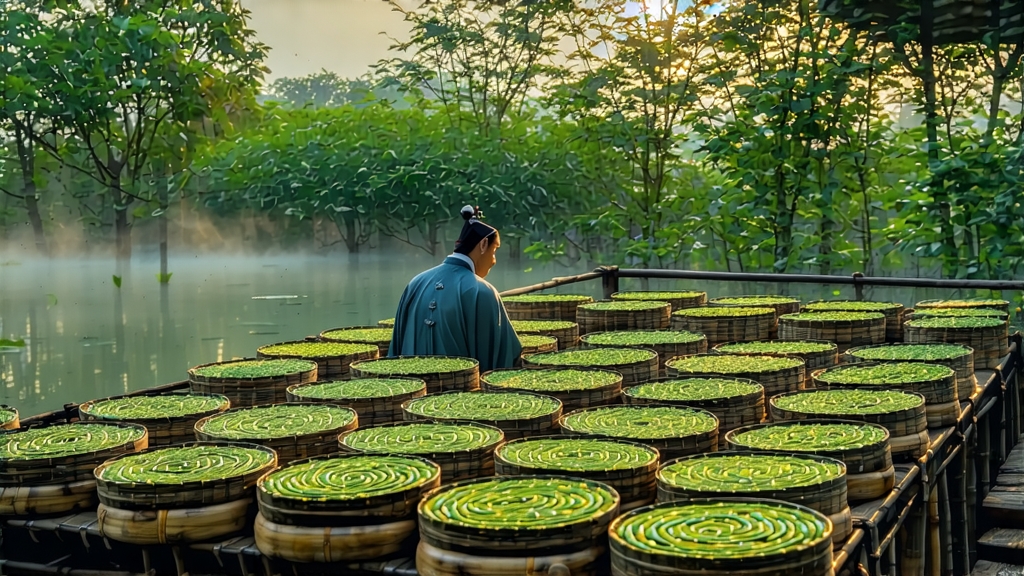
Biluochun, whose name translates literally to “Green Snail Spring,” is one of China’s ten most celebrated teas, yet it remains a delicate secret outside the circles of serious tea connoisseurs. Grown in the microclimate of the Dongting mountain range that rises from the shores of Taihu Lake in Jiangsu Province, this green tea seduces with a fragrance so intense that, according to Qing-dynasty legend, even pickers forget their wicker baskets and follow the scent uphill. The following 2,000 words invite you on a complete journey—from Tang-dynasty court tribute to your own porcelain gaiwan—so that you may understand why a single gram of Biluochun can contain an entire Chinese spring.
-
Historical Echoes: From Xiaoshi’s Garden to Imperial Tribute
The first written record appears in the Tang Dynasty’s “Tea Canon” supplements, where the tea is called “Xia Sha Ren Xiang” (Frighteningly Fragrant). Local lore insists a tea picker, Xiaoshi, stored fresh leaves in her apron while picking wild fruits; body heat caused an accidental gentle oxidation, releasing an orchid-like perfume that startled her. By the Song era, monks from the Dongting temples offered the tea to traveling scholars, cementing its literary reputation. The Kangxi Emperor, during his 1699 southern inspection tour, renamed it Biluochun after its snail-shell curve and spring harvest, elevating it to top-tier tribute. Manchu nobles soon competed to obtain the first fifty grams picked before Qingming festival, a custom that survives among modern collectors paying prices rivaling silver by weight. -
Terroir: Where Lake, Mist, and Fruit Intertwine
Unlike the high-altitude ruggedness of Yunnan or the limestone peaks of Wuyi, Biluochun’s terror is gentle: terraced orchards of loquat, plum, and apricot interplant with tea bushes on slopes between 100–300 m. Taihu’s vast water surface moderates temperature, creating 80 % humidity and perpetual morning fog that diffuses sunlight into soft, yellow-green wavelengths. The bushes therefore synthesize more amino acids (especially L-theanine) and fewer bitter catechins, yielding a naturally sweet, almost creamy liquor. Soils are acid loam rich in ferric oxide from weathered quartzite, draining quickly yet retaining enough moisture for the shallow root systems. Each March, when night temperatures hover around 8 °C and days rise to 18 °C, the bushes awaken with tiny, hairy buds that will become the prized “one bud with one leaf” standard. -
Cultivars: Beyond the Generic “Dongting”
Most export labels simply say “Biluochun,” but within the 17 km² core zone three clonal cultivars dominate.
• Fuding Da Bai Hao (introduced 1974) gives fat silvery buds and a magnolia nose, yet can taste thin if over-fired.
• Dongting Qunti Zhong (“group seed stock”) is the heirloom population propagated by seed; leaves are smaller, more aromatic, and withstand lower firing temperatures, preserving orchid notes.
• Wannan Early Sprout, a 1998 cross, flushes ten days earlier, allowing farmers to market “pre-Qingming” lots at premium, though it lacks the sustained aftertaste of Qunti Zhong. Discerning buyers look for the cultivar code printed in microscopic characters on the tin’s bottom seal. -
Harvest Calendar: The 48-Hour Race
Picking begins when 5 % of buds reach “sparrow’s tongue” length (1.5–2 cm). Experienced dippers (usually women aged 35–55) pluck between 5:30 a.m. and 9:00 a.m., while dew still weighs down the leaves, preventing oxidation during transport. Each picker fills a shallow bamboo “douli” basket every 30 minutes; leaves are then transferred to a shaded shed where they are spread on sieves for two hours of withering—unique among green teas. This brief withering reduces grassy notes and concentrates precursor volatiles. By noon, the first batch must reach the wok; any delay risks enzymatic browning that would destroy the jade color. -
Crafting the Spiral: Hand-Firing in Three Acts
Traditional production uses only 30 cm diameter iron woks heated by lychee wood, maintaining 180 °C for kill-green, 120 °C for rolling, and 70 °C for